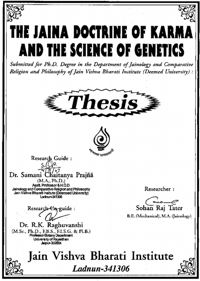If all the holes of a boat are plugged, no water enters. Similarly when one stops all the activities leading to āsṛava like mithyāttva etc. he prevents the influx of karmas. The process of stopping the influx is the best device for a living being. Asṛava is the problem and Saṁvara is the solution. Āsṛava is the state of sleepness and saṁvara is the state of alertness. Āsṛava takes jīva to a lower level, and the Saṁvara takes the jīva to a higher level. Saṁvara is the right thing to do, it is the right path of spiritual progress.
Every worldly soul happens to be confined (not free). The imprisonment is due to the bondage of karma (baṅdha). To be free jīva has to eradicate the karmas he is bound by. The process of eradicating the karmas is called Nirjarā. The word nirjarā means to fall off. It denotes dripping off, destruction, or removal of karmas from the soul. Inflow of karma is due to āsṛava, the stoppage of the inflow is due to saṁvara and the eradication of karma is due to Nirjarā. Jīva can shed the karmas and purify his soul with the help of austerities.
Saṁvara
Literally, Saṁvara means blocking. Saṁvara, in theory of karma, means blockage or stoppage of the inflow of karmas to the soul. It is opposite of Āsṛava, which means inflow of karmas. In the discussion of āsṛava in previous chapter, we gave the example of boating, which also explains how saṁvara works. Let us pretend as if we went boating. We were having good time and suddenly noticed water rising on the floor of boat. We immediately felt that the boat had a hole and if the leak was not fixed the boat would sink. So, the first thing we did was to find the hole and seal it so that new water would stop coming in. This stoppage of water coming in is called saṁvara. A similar situation is that of our soul which is wandering in worldly affairs. We have so many holes (activities) through which karmas are flowing in at all the times. We talked about these holes when discussing āsṛava, such as mithyātva (wrong beliefs), avirati (vowlessness), kaṣāya (passions), pramāda (indolence) and yoga (activities). These activities allow karmas to become attached to the soul. Once we have realized the effects of such activities, we need to work towards overcoming them so that we can stop new karmas coming in before they further sink the soul. Saṁvara can be described in two types:[1]
- Physical or objective.
- Psychic or subjective.
The physical refers to the actual shutting of our activities which leads to stoppage of the inflow of karmas. The psychic means consciously striving to stop our passions.
Saṁvara is of 6 kinds:
- Samiti (careful activity),
- Gupti (restraint of the activity),
- Yati dharma (dharma of monks),
- Bhāvanās (mental reflections),
- Parīṣaha (natural sufferings),
- Cāritra (conduct). [2]
These 6 types of Saṁvara will be efficacious and real only if they are carried out with a firm faith in the commands of the Jina. Therefore, samyaktva is deeply and intimately connected with saṁvara. Through samyaktva, the āsṛava called mithyātava i.e. wrong belief is completely blocked and stopped. By means of samyakcāritra and yati-dharma, the āsṛava called avirati i.e. vowlessness is blocked. By means of gupti, bhāvanās and yati-dharma theĀsṛava called kaṣāya i.e. passions is blocked. By means of samiti, gupti, parīṣaha etc. yoga and pramāda are blocked. By means of cāritra, the āsrava called vowlessness, passions, activities together can be blocked. [3]
 Prof. Dr. Sohan Raj Tater
Prof. Dr. Sohan Raj Tater
 Doctoral Thesis, JVBU
Doctoral Thesis, JVBU